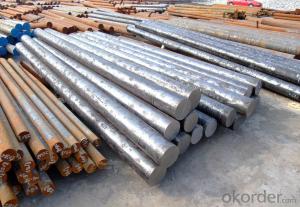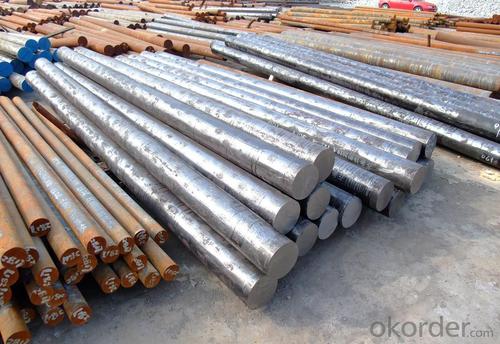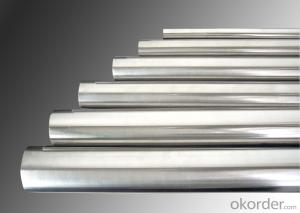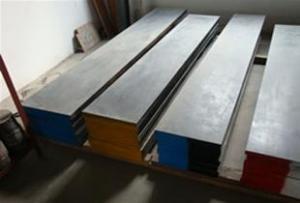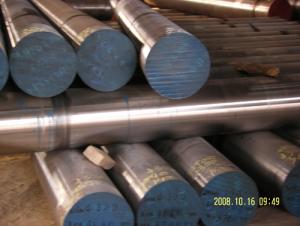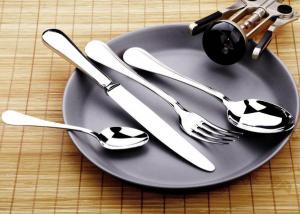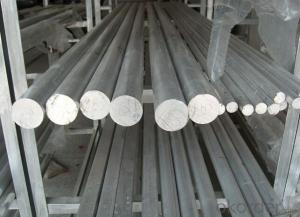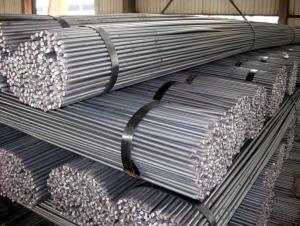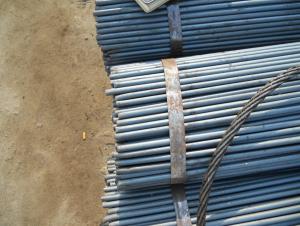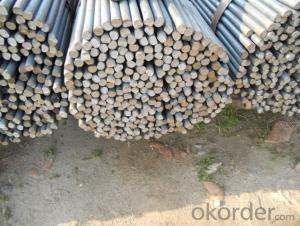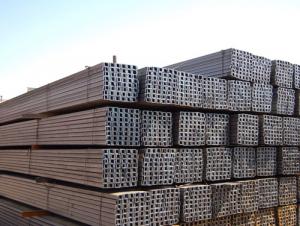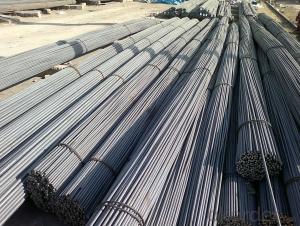1Cr18Mn8Ni5N202 Stainless High Quality Tool Steel
- Loading Port:
- China main port
- Payment Terms:
- TT or LC
- Min Order Qty:
- 25 m.t.
- Supply Capability:
- 10000 m.t./month
OKorder Service Pledge
OKorder Financial Service
You Might Also Like
Product Description:
OKorder is offering Tool Steel at great prices with worldwide shipping. Our supplier is a world-class manufacturer of steel, with our products utilized the world over. OKorder annually supplies products to European, North American and Asian markets. We provide quotations within 24 hours of receiving an inquiry and guarantee competitive prices.
Product Applications:
High Quality Bearing steel is used for manufacturing ball, roller bearing steel and rings. Bearing in work is under great pressure and friction, so have high demands bearing steel and hardness and resistance, and high elastic limit.
Bearing steels are used for ball and roller bearing applications and are comprised of low carbon steels and high carbon through harden able steel.
For example, bearing ring, steel rolling mill, machinery, 100Cr6 bearing steel ball is widely used in high-speed and low-noise bearing, bicycle, motorcycle, automobile, bags electronically.
Product Advantages:
OKorder's Tool Steel are durable, strong, and resist corrosion.
Main Product Features:
· Premium quality
· Prompt delivery & seaworthy packing (30 days after receiving deposit)
· Corrosion resistance
· Can be recycled and reused
· Mill test certification
· Professional Service
· Competitive pricing
Product Specifications:
Grade | bearing steel EN-31 |
Dimensions | Diameter: 20-280mm Length: 2000-5800mm |
Shape | Round Bar |
Type | High chromium bearing steel |
HBS | <220< span=""> |
Standard | AISI |
Technique | Hot Rolled |
Chemical Composition of High Quality Bearing Steel
C | S | P | Si | Mn |
0.95-1.05 | ≤0.025 | ≤0.025 | 0.15-0.35 | 0.25-0.45 |
Cr | Mo | Ni | Cu | Ni+Cu |
1.40-1.65 | ≤0.10 | ≤0.30 | ≤0.25 | ≤0.50 |
Note of High Quality Bearing Steel
1. According to national standard (GB) for our products, if not, supply according to national standards (GB) or agreement.
2. We can not only provide electric furnace +LF+VD and electros lag re-melting (ESR) steel forging materials, but also forging products of piece, bar, etc.
3. Our company is equipped with roll equipment and can provide our customers with roll billets or finished.
4. The materials that we purchase are all accord with International General Standard; you could check it out on the Material Quality Sheet.
5. We are the creator of the “seven-step inspect method” in China.
FAQ:
Q1: Why buy Materials & Equipment from OKorder.com?
A1: All products offered byOKorder.com are carefully selected from China's most reliable manufacturing enterprises. Through its ISO certifications, OKorder.com adheres to the highest standards and a commitment to supply chain safety and customer satisfaction.
Q2: How do we guarantee the quality of our products?
A2: We have established an advanced quality management system which conducts strict quality tests at every step, from raw materials to the final product. At the same time, we provide extensive follow-up service assurances as required.
Q3: How soon can we receive the product after purchase?
A3: Within three days of placing an order, we will begin production. The specific shipping date is dependent upon international and government factors, but is typically 7 to 10 workdays.
Images:
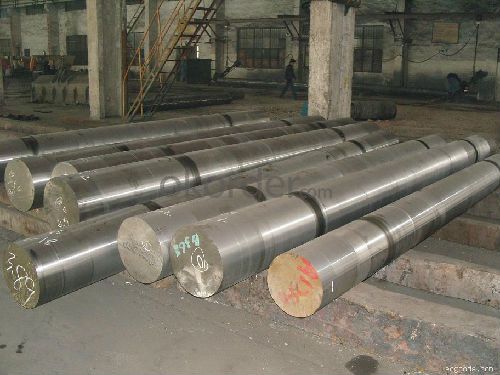
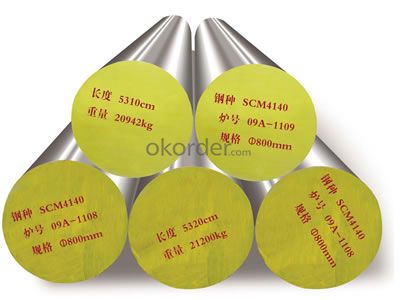
- Q: What is the difference between seamless and welded steel round bars?
- The main difference between seamless and welded steel round bars lies in their production process. Seamless steel round bars are made by piercing a solid steel billet to create a hollow tube, which is then elongated and rolled to the desired size and shape. On the other hand, welded steel round bars are formed by welding together two or more pieces of steel, typically using a fusion process. This results in a visible seam along the length of the bar. While seamless bars offer a smoother and more uniform surface, welded bars are generally more cost-effective and readily available in a wider range of sizes and lengths.
- Q: Can steel round bars be used for decorative purposes?
- Indeed, decorative purposes can be served by steel round bars. When utilized in diverse architectural and interior design ventures, they contribute a contemporary and industrial appeal. By shaping, bending, and welding steel round bars, one can fashion exclusive and attention-grabbing items like furniture, sculptures, railings, and decorative accents. Their polished and metallic look harmonizes with various styles and design motifs, rendering them a versatile option for embellishment. Moreover, the durability and longevity of steel round bars guarantee that these decorative elements will endure the passage of time.
- Q: Can steel round bars be coated or painted?
- Steel round bars have the capability to undergo coating or painting. The purpose of coating or painting steel round bars is manifold; it prevents corrosion, enhances aesthetics, and provides additional protection against environmental factors. There are several methods available for applying coatings and paints to steel round bars, including powder coating, electroplating, or wet paint application. These processes involve first preparing the surface of the steel round bar by removing any existing rust or contaminants, and then applying the chosen coating or paint. The selection of the appropriate coating or paint depends on the specific requirements of the steel round bars, such as their intended use, environmental conditions, and desired appearance. By coating or painting steel round bars, their lifespan can be significantly extended, their visual appeal can be improved, and their durability can be ensured in a wide range of applications.
- Q: How many grades of steel are round steel?
- Secondly, the round steel only shows the shape of steel, all kinds of steel have round steel, it can not explain the nature and composition of steel.
- Q: Difference between round bar and other steel bars
- Round steel is a solid strip of steel whose cross section is round. The specifications are expressed in millimeters of diameter, such as "50", which means a round bar of 50 millimeters in diameter.
- Q: How do you calculate the cross-sectional area of a steel round bar?
- To calculate the cross-sectional area of a steel round bar, you need to know its diameter or radius. The formula for calculating the cross-sectional area of a circle is A = πr^2, where A is the area and r is the radius of the circle. If you have the diameter of the round bar, you can divide it by 2 to get the radius. Once you have the radius, you can substitute it into the formula to calculate the cross-sectional area. Keep in mind that the value of π is approximately 3.14159.
- Q: Can steel round bars be heat treated to improve their mechanical properties?
- Yes, steel round bars can be heat treated to improve their mechanical properties. Heat treatment involves heating the steel to a specific temperature and then cooling it at a controlled rate. This process can alter the microstructure of the steel, resulting in improved hardness, strength, and toughness. Different heat treatment methods, such as quenching and tempering, can be applied depending on the desired mechanical properties.
- Q: What is the difference between a turned and a ground steel round bar?
- A turned steel round bar and a ground steel round bar are two different types of steel bars that have undergone different manufacturing processes. A turned steel round bar is created by rotating a cylindrical steel rod against a cutting tool, which removes material from the surface of the bar to achieve the desired dimensions and finish. This process helps to improve the dimensional accuracy and smoothness of the bar's surface. Turned steel round bars are commonly used in applications that require tight tolerances and a smooth surface finish, such as in precision machining or automotive components. On the other hand, a ground steel round bar is manufactured by passing a turned steel round bar through a grinding machine. This machine uses an abrasive wheel to remove any surface imperfections or irregularities from the bar. The grinding process ensures that the bar has a consistent diameter and a smooth, polished surface. Ground steel round bars are often used in applications that require a high level of precision and surface finish, such as in aerospace components or hydraulic cylinders. In summary, the main difference between a turned and a ground steel round bar lies in the manufacturing processes they undergo. While turned bars are created by cutting material from the surface, ground bars are refined by grinding to achieve superior dimensional accuracy and surface smoothness. The choice between turned and ground steel round bars depends on the specific requirements of the application and the level of precision and surface finish needed.
- Q: Do steel round bars have a maximum load capacity?
- Yes, steel round bars have a maximum load capacity. The maximum load capacity of a steel round bar is determined by various factors such as the diameter and length of the bar, the type and grade of steel used, and the specific application or industry standards it is being used in. The load capacity is usually determined through testing and analysis, taking into consideration factors like yield strength, ultimate tensile strength, and the ability of the bar to withstand bending or deformation under load. It is important to consult engineering specifications and guidelines to ensure that the maximum load capacity of a steel round bar is not exceeded in order to maintain safety and structural integrity.
- Q: What are the advantages of using sulfur-alloy steel round bars?
- There are several advantages of using sulfur-alloy steel round bars. Firstly, sulfur-alloy steel round bars offer improved machinability, making it easier to shape and cut the material into desired forms. Additionally, the sulfur content in the alloy enhances the overall strength and hardness of the steel, making it more durable and resistant to wear and tear. Moreover, sulfur-alloy steel round bars have excellent thermal conductivity, allowing for efficient heat transfer during various applications. Lastly, these bars are cost-effective as they offer a combination of desirable properties at a relatively lower price compared to other specialized alloys.
Send your message to us
1Cr18Mn8Ni5N202 Stainless High Quality Tool Steel
- Loading Port:
- China main port
- Payment Terms:
- TT or LC
- Min Order Qty:
- 25 m.t.
- Supply Capability:
- 10000 m.t./month
OKorder Service Pledge
OKorder Financial Service
Similar products
Hot products
Hot Searches
Related keywords
